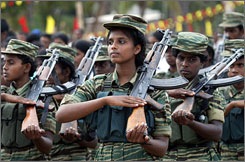 Two months after President Mahinda Rajapakse vowed that the Tamil Tiger rebels would be defeated within days, fighting rages on in Sri Lanka at the cost of escalating military, rebel and civilian lives.
Two months after President Mahinda Rajapakse vowed that the Tamil Tiger rebels would be defeated within days, fighting rages on in Sri Lanka at the cost of escalating military, rebel and civilian lives.
Government forces who were advancing into Liberation Tigers’ of Tamil Eelam (LTTE) territory at the rate of more than a kilometre (0.6 miles) a day have slowed to a snail’s pace.
With the rebels now cornered in a tiny but densely populated strip of coastal jungle measuring just 21 square kilometres (eight square miles), the military has been struggling to deliver the final blow.
The army says the Tigers have fewer than 500 fighters left, but those that remain appear to be offering stiff resistance.
"It is a matter of life and death for the Tigers and that is why they are ferociously fighting back," said former Tiger militant-turned-politician Dharmalingam Sithadthan.
"They are also using a human shield very effectively."
United Nations and other foreign aid organisations say as many as 150,000 civilians may be trapped in the combat zone, although the Sri Lankan government insists the figure is less than half that.
Military officials say the proximity of the two sides’ frontlines made it impossible to use heavy artillery, multi-barrel rockets and jet aircraft to soften up Tiger targets ahead of advancing ground forces.
"Progress is going to be slow because we are very, very close and can’t fire long-range weapons," said military spokesman Brigadier Udaya Nanayakkar.
"Also, we can’t move as rapidly as we would like because of the civilians," Nanayakkar said. "We can’t just go in."
A senior military officer who declined to be named said there were fears the Tigers might stage a mass suicide involving civilians as well as their own fighters.
"The military expected the civilians to put pressure on the Tigers and break free and allow the army to go in and finish the job," the officer said. "But the Tigers have used enough terror to prevent civilians from escaping."
At the height of their power in the mid-1990s, the Tigers controlled more than two-thirds of the island’s coastline and a third of the total land mass as they pushed for an independent Tamil homeland.
Their collapse began two years ago and accelerated after the government pulled out of a Norwegian-brokered truce in January 2008.
The UN has criticised the Tigers for not allowing non-combatants to flee the conflict area, while also urging the government to halt its shelling operations.
The UN human rights chief, Navi Pillay, has said that over 2,800 civilians have been killed in shelling since January 20 — a charge denied by the Sri Lankan authorities.
President Rajapakse made his prediction of imminent victory in an address to mark Sri Lanka’s national day on February 4.
"I am confident that the Tigers will be completely defeated in a few days," the president said then.
The Tigers responded two weeks later by flying explosives-laden light aircraft over the capital Colombo and bombing the main income tax office. The attack was a minor one but still symbolic of the rebels’ resilience.
Last week, the government’s defence spokesman, Keheliya Rambukwella, revived the claim that the fighting was in its final phase.
"It is apparent that the LTTE are now on the imminent brink of defeat," said Rambukwella.
But the Tigers have fought on.
(For updates you can share with your friends, follow TNN on Facebook and Twitter )
